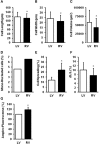Review on Chamber-Specific Differences in Right and Left Heart Reactive Oxygen Species Handling
- PMID: 30618811
- PMCID: PMC6304434
- DOI: 10.3389/fphys.2018.01799
Review on Chamber-Specific Differences in Right and Left Heart Reactive Oxygen Species Handling
Abstract
Reactive oxygen species (ROS) exert signaling character (redox signaling), or damaging character (oxidative stress) on cardiac tissue depending on their concentration and/or reactivity. The steady state of ROS concentration is determined by the interplay between its production (mitochondrial, cytosolic, and sarcolemmal enzymes) and ROS defense enzymes (mitochondria, cytosol). Recent studies suggest that ROS regulation is different in the left and right ventricle of the heart, specifically by a different activity of superoxide dismutase (SOD). Mitochondrial ROS defense seems to be lower in right ventricular tissue compared to left ventricular tissue. In this review we summarize the current evidence for heart chamber specific differences in ROS regulation that may play a major role in an observed inability of the right ventricle to compensate for cardiac stress such as pulmonary hypertension. Based on the current knowledge regimes to increase ROS defense in right ventricular tissue should be in the focus for the development of future therapies concerning right heart failure.
Keywords: MAO; cardiac remodeling; heart failure; oxidative stress; pulmonary hypertension; uncoupling protein.
Figures



References
-
- Abraham W. T., Raynolds M. V., Badesch D. B., Wynne K. M., Groves B. M., Roden R. L., et al. . (2003). Angiotensin-converting enzyme DD genotype in patients with primary pulmonary hypertension: increased frequency and association with preserved haemodynamics. J. Renin. Angiot. Aldoster. Syst. 4, 27–30. 10.3317/jraas.2003.003 - DOI - PubMed
-
- Adesina S. E., Wade B. E., Bijli K. M., Kang B. Y., Williams C. R., Ma J., et al. . (2017). Hypoxia inhibits expression and function of mitochondrial thioredoxin 2 to promote pulmonary hypertension. Am. J. Physiol. Lung Cell. Mol. Physiol. 312, L599–L608. 10.1152/ajplung.00258.2016 - DOI - PMC - PubMed
-
- Alzoubi A., Toba M., Abe K., O'Neill K. D., Rocic P., Fagan K. A., et al. . (2013). Dehydroepiandrosterone restores right ventricular structure and function in rats with severe pulmonary arterial hypertension. Am. J. Physiol. Heart Circ. Physiol. 304, H1708–H1718. 10.1152/ajpheart.00746.2012 - DOI - PubMed
LinkOut - more resources
Full Text Sources

